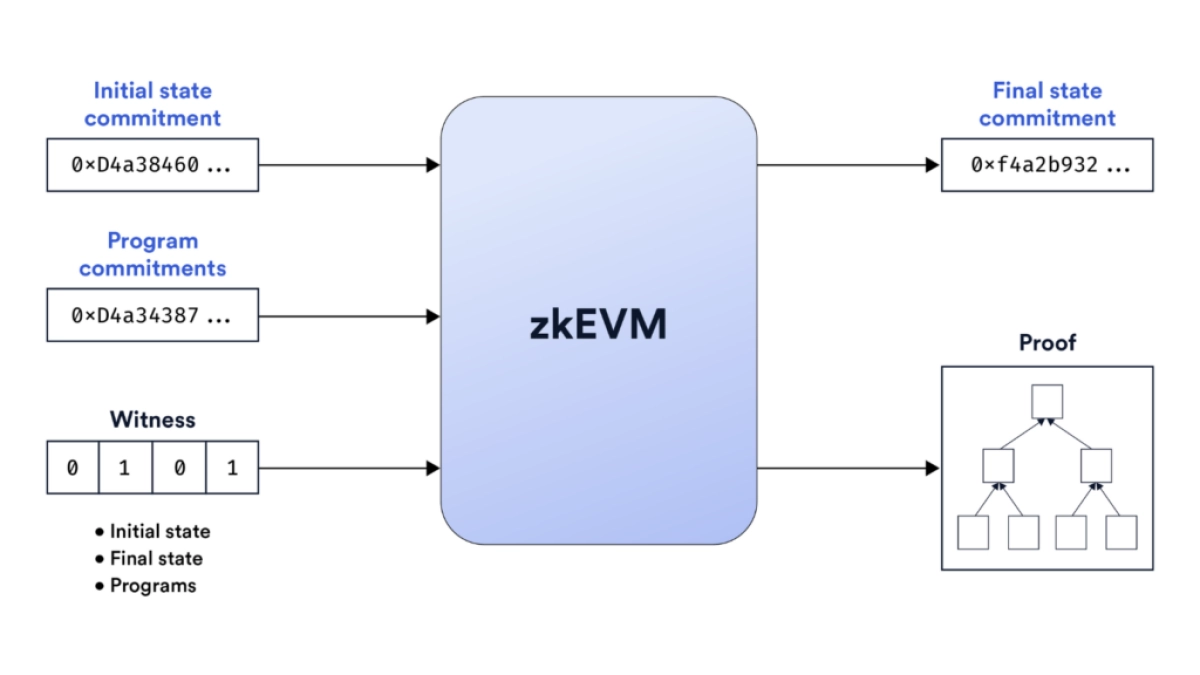时间:2024-03-01|浏览:304

zkEVMs can validate and execute blockchain operations without needing to expose all the details. It's like saying, "I can prove this transaction or contract is valid and follows the rules, but I won't show you all the inner workings of it." Image source: Chainlink
While zkEVMs opened promising doors, they realized their potential posed major technical challenges. The EVM was never designed with proof, so several aspects conflict with this new paradigm.
For one, the EVM's stack-based architecture proved difficult to convert to a format compatible with proving. Its special opcodes for error handling also confounded efforts to build verifiable circuits.
Storage was another hurdle, as the EVM's Merkle Patricia tree clashed with proving needs. Replacing the KECCAK256 hashing function helped but risked breaking infrastructure compatibility.
Most significantly, zero-knowledge proofs demand computationally-intensive operations that drive up costs, especially on-chain. Generating and verifying proofs for each smart contract execution transaction consumed prohibitive resources.
Addressing these issues required rethinking core EVM components and sparking innovations in proofs like optimized circuits and hybrid STARK-SNARK schemes. Much progress has been made, though optimizations continue as the field matures. Perfecting zkEVMs necessitated reconciling two dissimilar yet essential technologies.
While research continues, several zkEVM systems have already launched, each approaching the technical challenges somewhat differently:
Beyond technical distinctions, these zkEVMs also vary in features, user experience optimizations, and partnership ecosystems. All represent significant milestones in proving EVM compatibility while maintaining practical usability and performance.
| Project | Approach | Target Users | Unique Strengths |
|---|---|---|---|
| Polygon Hermez | EVM-compatible, SNARK-based | DeFi protocols, DEXes | High volumes, ETH-centric |
| zkSync | EVM, SNARK-based, JAASM | DeFi, dApps, Developers | Speed, Decentralization |
| AppliedZKP | zkVM, circuits | Researchers, Builders | Security research focus |
| Matter Labs Loop | zkSNARKs, optimistic | dApps, protocols | Flexible assumptions |
Popular zkEVM Projects and Focus Areas
By reconciling Ethereum's versatile smart contracts with privacy-preserving scaling, zkEVMs promise a wealth of benefits for both users and developers:
Widespread adoption of zkEVMs could realize the vision of Ethereum serving as a universal decentralized backplane, with layer 2 networks unleashing its full potential through scalability and privacy. However, challenges remain in proliferating these benefits.
While zkEVMs have advanced by leaps and bounds conceptually, major hurdles persist between research and widespread usability at scale. Chief among these are high deployment costs that presently constrain zkEVM usage to niche scenarios and limit overall throughput.
Additionally, integrating complex zkEVM proofs fully into applications introduces UI/UX challenges and risks reducing developer productivity versus more straightforward solutions. However, projects like Manta are working intensively to abstract away this complexity.
Looking ahead, continued optimizations to zkSNARKS/STARKS construction, circuit design, and refining the EVM abstraction layer give hope that costs and usability gaps will steadily recede. Promising developments like zkPorter rollup aggregators may further boost throughputs.
随着 zkEVM 采用的不断增长,其他研究途径(例如减少证明大小、提供高级密码学云服务以及使用专用硬件)也值得探索。
网络之间的互操作性也仍处于萌芽阶段。
底线
尽管挑战依然存在,但 zkEVM 的进展揭示了一个未来,即使是大规模的去中心化应用程序也可以通过智能合约保持私密性、低成本和完全信任——这些目标在几年前似乎是不可想象的。
目前,早期的例子证明了这个概念的有效性。
明天等待着它们广泛、用户友好的现实。
如果您想了解有关区块链技术支持的独特计算用例的更多信息,请查看我们关于去中心化物理基础设施网络 (DePIN) 的文章。
![[斯科特]了解 zkEVM:将智能合约引入第 2 层 | 币法典](/img/20240301/3656120-1.jpg)
![[斯科特]了解 zkEVM:将智能合约引入第 2 层 | 币法典](/img/20240301/3656120-1.jpg)

![[斯科特]Flow价格上涨预测达1.81美元|币法典](/img/btc/106.jpeg)



![[加密艺术家]zkEVM:未来游戏代名词](/img/btc/47.jpeg)
![[加密艺术家]不可变的zkEVM:区块链游戏的未来代名词](/img/btc/28.jpeg)
